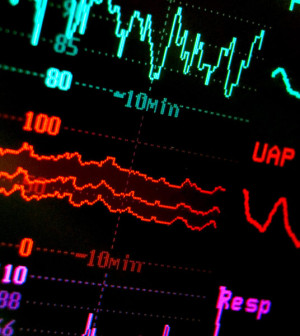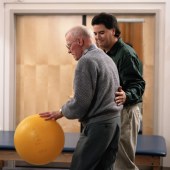- Navigating Your Midlife Crisis: Embracing New Possibilities
- City Raccoons Showing Signs of Domestication
- Mapping the Exposome: Science Broadens Focus to Environmental Disease Triggers
- One Week Less on Social Media Linked to Better Mental Health
- Your Brain Changes in Stages as You Age, Study Finds
- Some Suicide Victims Show No Typical Warning Signs, Study Finds
- ByHeart Formula Faces Lawsuits After Babies Sickened With Botulism
- Switch to Vegan Diet Could Cut Your Greenhouse Gas Emissions in Half
- Regular Bedtime Does Wonders for Blood Pressure
- Dining Alone Could Mean Worse Nutrition for Seniors
Intense Therapy Helps Restore Arm Function Long After Stroke: Study


Intensive physical therapy helps restore arm function in people who have survived a severe stroke, a new study finds.
University of Florida researchers followed 39 patients who underwent intense physical therapy for the arms five hours a day, five days a week, for 12 weeks.
For the study, the team “enrolled people who had a stroke a year or more prior to their study participation, and who were still severely impaired,” lead researcher Janis Daly, a professor of neurology in the College of Medicine, said in a university news release.
“The magnitude of recovery we observed in our study is higher than any other studies that have been published so far, which supports the promise of longer treatment and more intensive treatment after stroke, even for those who are more severely impaired,” she added.
Three rehabilitation methods were used. One was motor learning rehabilitation, in which patients concentrate on performing a movement as deliberately as possible and constantly repeat the movement.
Another method was electrical stimulation rehabilitation, in which electrodes stimulate the muscles on the forearm and cause the hand to lift. The third method was robotics-assisted rehabilitation, in which robotics software assists with arm movement.
One group of patients did five hours a day of motor learning alone, while the other patients did motor learning for 3.5 hours and either electrical stimulation or robotic-assisted therapy for 1.5 hours.
On average, patients in all three groups doubled or nearly doubled the ability to use their stroke-affected arm, according to the study.
“The recovery was meaningful to patients in terms of physical function. Each person’s recovery was somewhat unique,” said Daly, who is also director of the National Veterans Affairs Brain Rehabilitation Research Center of Excellence in Gainesville.
“Some had dramatic recovery, some had less,” Daly explained. “Some were able to perform functional tasks that they weren’t able to do before; some recovered the ability to move their arm so they could actually place the arm for functional tasks, for example into the sleeve of a sweater.”
A larger study is needed to confirm the findings, Daly noted.
The study was published in the June issue of the Archives of Physical Medicine and Rehabilitation.
When the researchers calculated the salaries of the therapists and the cost of rehab equipment, they estimated that treatment for each patient cost between $4,500 and $5,600.
More information
The U.S. National Institute of Neurological Disorders and Stroke has more about stroke rehabilitation.
Source: HealthDay
Copyright © 2025 HealthDay. All rights reserved.










